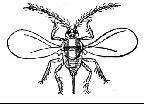Natural Solutions to Things That Bug You (74 page)
Read Natural Solutions to Things That Bug You Online
Authors: Myles Bader

Sowbug
Pillbugs and sowbugs are somewhat different, but will be found in the same area. They are hard to tell apart, but the easiest way is to know that the pillbug will roll up in a ball and the sowbug will end up with a “hump” and not be as round. Sowbugs also have gills and need constant moisture conditions to survive. They always feed at night and like decaying leaf litter and vegetable matter.
GET OUT THE MAGNIFYING GLASS
When you get new potted plants it is very important to quarantine the plants for about 30 days and be sure and examine them frequently for mealybugs.
THE BARKING PILLBUG
Pillbugs love dry dog food and if you sprinkle some dry dog food around the base of the plants they are bothering they will eat the dog food and stay away from the plants. Cat food may work as well.
ONION SPRAY
3 Onions
¼ Cup Ivory Liquid Soap™
4 Cups of cool tap water
Slice and peel the onions then place them in a food processor and cover them with water. Blend very well then allow them to stand for 24 hours before straining and adding the liquid soap.
THE POTATO TRAP

 Cut a raw potato in half and scoop out part of the insides then place it just below the surface of the ground where the pillbugs frequent. The pillbugs will congregate in the potato and can be discarded very easily.
Cut a raw potato in half and scoop out part of the insides then place it just below the surface of the ground where the pillbugs frequent. The pillbugs will congregate in the potato and can be discarded very easily.
CORNCOBS ATTRACT THEM
These bugs really like corncobs and if you just leave some corncobs in the areas you see them; they will find them and not bother other vegetation. If you get out real early in the morning or the very late night hours, you can retrieve the corncobs with the bugs on them and drop them into a pail of soapy water to kill them.
SPIDER LOVES PILLBUGS
A small spider named
Dysdera crocata
loves pillbugs and will hunt them. The spider is only ½ inch long with a brown rear body and a reddish front body with prominent fangs. It is harmless to humans and will run and hide when disturbed. The spider feeds almost exclusively on pillbugs and is usually found under rocks feeding at night.

ROOT MAGGOTS
Identification:
These look like houseflies and will lay their eggs in the soil. When they hatch the white maggots emerge looking like a grub with a pointed head.
They will burrow down to the roots of the plants and feed until the plant dies and wilts. They lay about 200 eggs at the base of the host plant.
General Information:
If you think that root maggots are your problem, just pull up the plant and see if there are little white maggots on the roots. The two most common root maggots are the cabbage and onion root maggots.
They prefer young seedlings. Their pupae spend the winter 1-6 inches into the soil then the flies come out in the spring and lay their eggs, immediately producing white maggots.

SERVE THEM TEA
Save all your used tea bags and place the loose tea in your planting mix or mulch. This acts as an excellent deterrent for maggots. Coffee grounds may work almost as well as the tea.
IT’S DARK IN HERE
Place old pieces of carpeting or pieces of tarpaper with slits cut around the base of the plants will stop the root maggots from getting to the roots. Cover the slits with a good waterproof tape. Maggots do not like the smell of tar, which is an excellent repellent.
MAKE A BARRIER
Try and acquire large quantities of eggshells from a local restaurant. Crush the eggshells and mix it in with the soil. You can also use DE or plain sawdust mixed in with the soil. This will stop them from burrowing in. Wood ashes can also be sprinkled around the base of the plant with good results.
REPELS 100% OF THE TIME
Prepare a mixture of equal parts of lime, rock phosphate and bone meal. Mix well then add an equal measure of wood ash. Place some of this mixture in the hole that you are planting in.
PARASITE KILLERS
You can order Nc nematodes or Chalcid and trichogramma wasps and release them as well as rove beetles.

ONION MAGGOT
General Information:
These maggots are more common in coastal areas. The maggot tapers to the head similar to the cabbage maggot. They damage the onions by feeding on the lower areas of the stem or bulb.
A single maggot is capable of destroying a number of seedlings by eating their underground parts. Several maggots will ruin a large onion by attacking the onion through its base where they enter the root and burrow upwards. If the damaged onions are placed into storage they will readily decay.

THEY LOVE ONIONS
These bugs love onions with the exception of yellow onions. Yellow onions will usually repel the bugs, however, red and white ones will not.
SPACE OUT THE PLANTS
Since home gardens are arranged in rows the maggots find it easy to go from one plant to another. You can stop this pest by scattering the onion plants all over the garden. Every maggot needs several young seedlings to survive or they will die after they eat one. If they can’t find the next seedling, they literally starve to death after their first meal.

ASHES TO ASHES
If you add sand or wood ashes to the top layer in planting rows it will stop the maggots and kill them.
SCALE
General Information:
Scales have similar biology to mealybugs but with a white waxy covering and a hard shell of a variety of colors. There are about 1,700 species. Most do not lay eggs but bear live nymphs.
They will reproduce faster indoors, which may be as little as a month while outdoor scales may take up to a year. There are soft scales and hard scales and it takes different methods to get rid of them so identification is a must.
SOFT SCALE VS HARD SCALE
To get rid of soft scales or black scales a wasp parasite,
Metaphycus helvolus
will solve the problem. To get rid of the hard, red scales call in the parasite
Aphytis melinus
to kill off the scale.
Another, good scale eradicator is the ladybug
Chilococorus nigritis
. Actually, almost any ladybug beetle will be glad to eat your scales.
SWAB THEM
